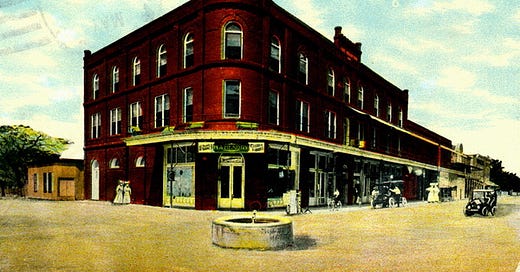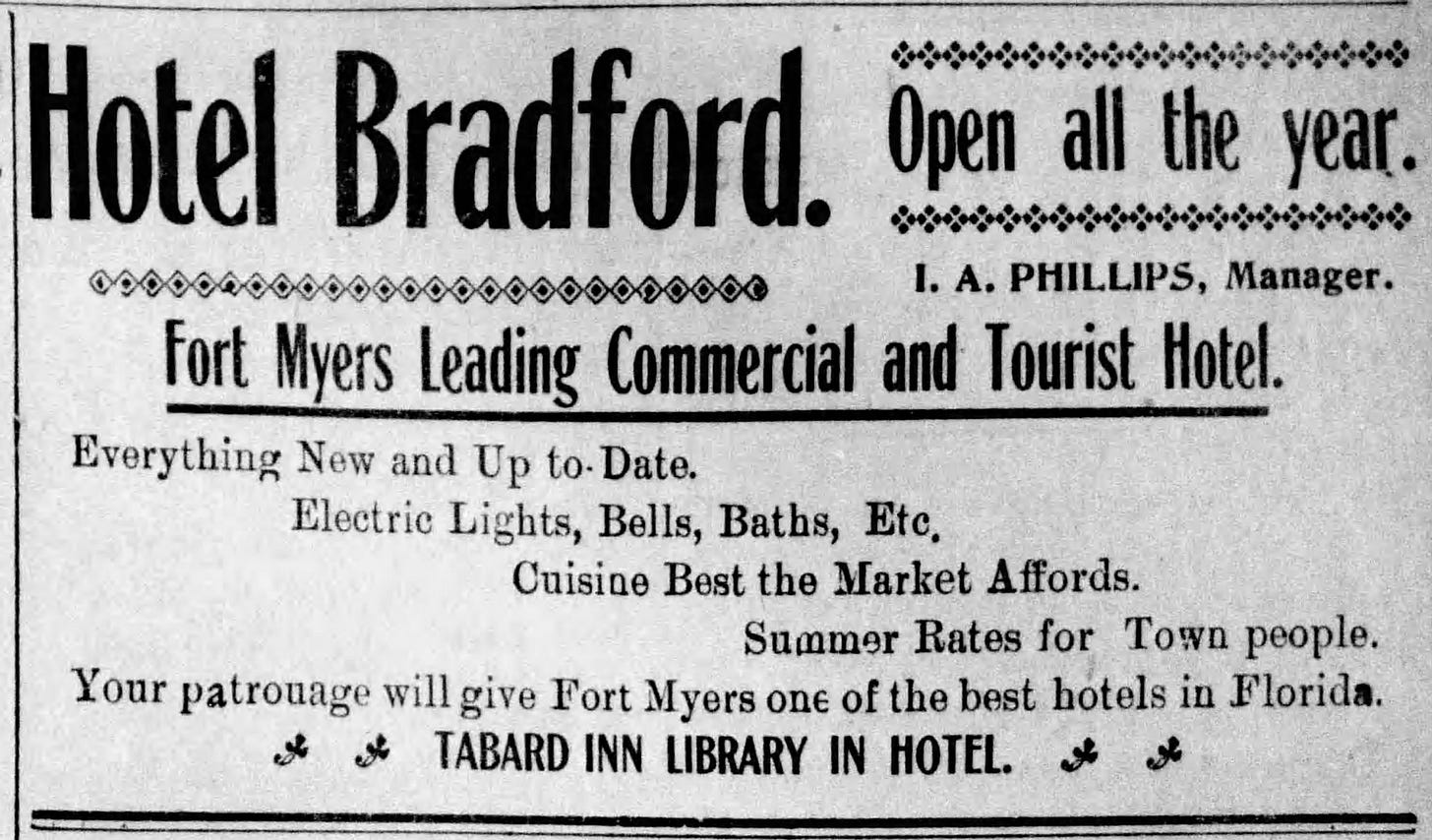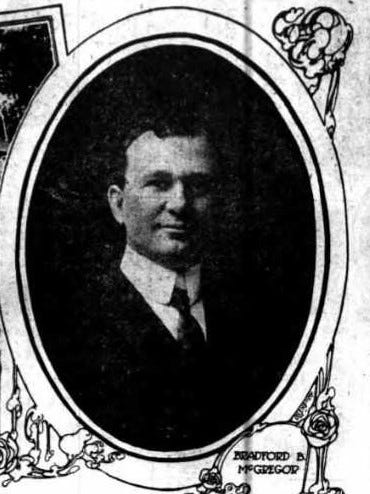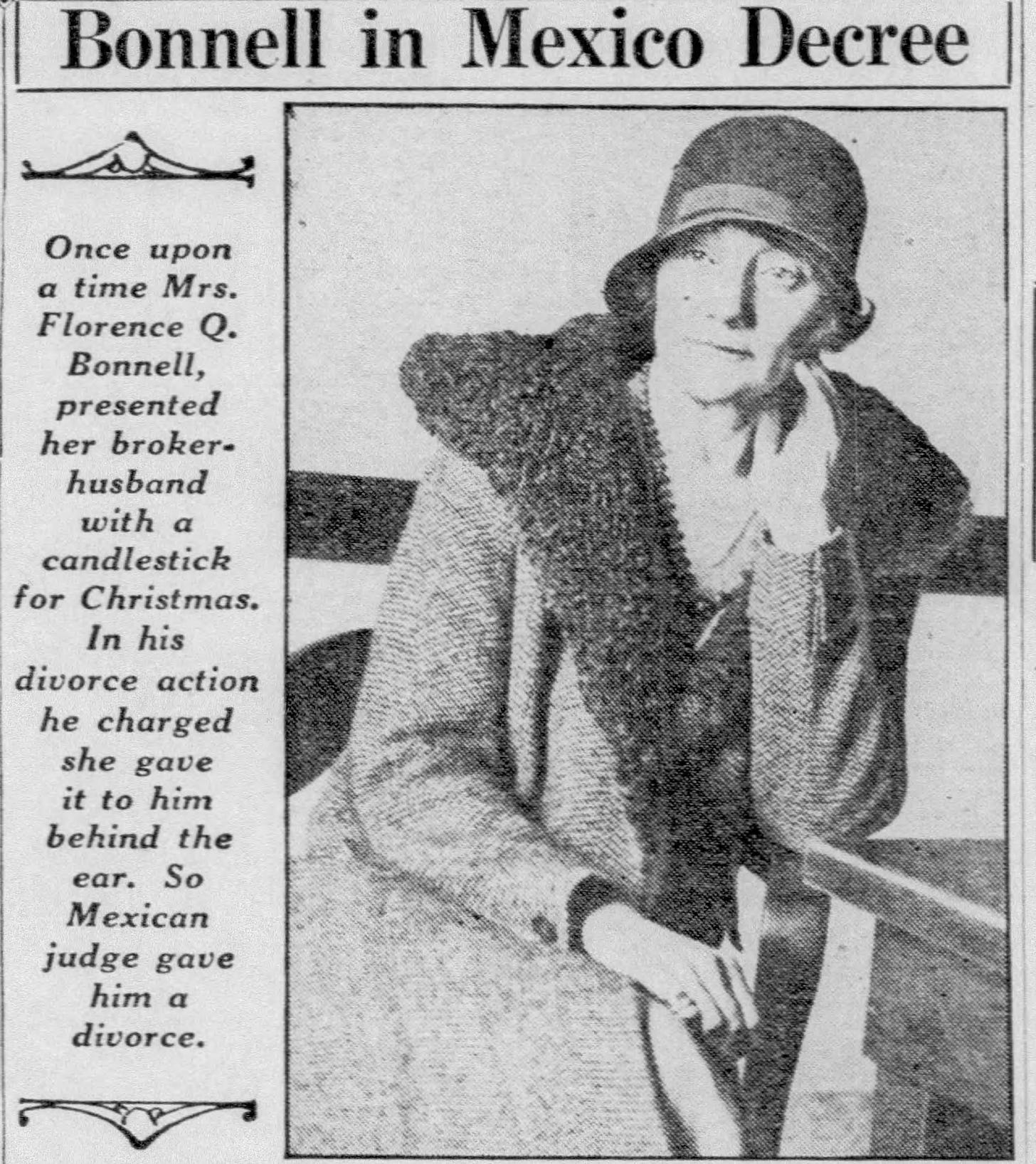In January 1905, Fort Myers Press announced that Harvie Heitman was at work on a magnificent block-long, three-story brick building at First and Hendry streets in Fort Myers.
Merchants were already signed up to go into the new street-facing storefronts on the new block. On the top two floors, Heitman was building a commercial hotel, to be called The Bradford. The Bradford for whom it was named was Bradford Barber McGregor (1868-1902), the son of Tootie McGregor and her late husband, Standard Oil’s Ambrose McGregor. The McGregors were early backers of Heitman, a business wunderkind.
The hotel, with more than 40 rooms, had electricity, hot water, a central kitchen, and more. It welcomed its first guests November 1905. Today, after numerous expansions, renovations, and reconfigurations, the Bradford block is still the heart of Fort Myers’ downtown historic district.
(Fort Myers Press ad, 1906)
Who was Bradford McGregor?
Bradford was the only child of Ambrose and Tootie McGregor, born in 1868 and raised in Cleveland. The family later moved to New York. He apparently became ill with what was thought to be Bright’s Disease in the early 1890s, and he and his parents visited Southwest Florida, for his health, in 1892.
(Newspaper photograph of Bradford McGregor published after his death in 1902)
Despite his illness, Bradford was active in yachting, hunting, golfing, racing, and other sports. That first winter, he and his parents regularly caught record-sized tarpon. The McGregors soon began looking for a house in Fort Myers.
Thomas Edison and his onetime business partner Ezra Gilliland had purchased riverfront land just southwest of downtown in the 1880s and had two homes side-by-side. But Gilliland and Edison had a nasty split, and Gilliland sold his home to the McGregors in 1892. Edison did not return to Fort Myers for a long time.
In addition to the Gilliland place, which the family called Poinciana, Ambrose McGregor bought the upriver homestead of the late Dr. James Kellum, where Ambrose planted tobacco and kept a citrus grove. Within a few years Bradford was in charge of the farm, called Caloosa.
Bradford McGregor married Florence Quintard in Rye, N.Y., in November 1894. The couple and Tootie arrived in Florida on the family’s yacht, Whim, in December. Florence seems to have been game for whatever fun was to be had in Southwest Florida. She and Bradford camped in the Everglades in January, and she set a tarpon record of her own before the family returned to New York in April.
They returned in winter 1896. In autumn 1897 Bradford and Florence went out west to tour some of Bradford’s mining interests, finding friends and society in Deadwood, S.D.
In 1899, Florence’s father, who owned an iron works, died and left her more than $100,000. She was not with Bradford when he came to visit his parents in Florida in 1900. (Ambrose would die of cancer later that year.) Florence and a sister both filed for divorce from their husbands in Clark, S.D. Bradford and Florence’s divorce was final in spring 1901. She married John G. Richardson, a prominent Wall Street banker, within the year.
After his divorce and the death of his father, Bradford’s health worsened. At his and his mother’s home in Mamaroneck, N.Y., in September 1902, he opted to undergo a risky surgery to cure his kidney problems. Before the operation, he wanted to marry his fiancée, Clara Schlemmer. She had been touring Europe with her parents, and he cabled her to come back. She arrived at the McGregor estate with her brother within a few days.
On the morning of September 7, an Episcopal minister performed the wedding ceremony, with Bradford propped up on the bed with pillows. Clara’s brother and Tootie were among the handful of witnesses.
A few hours later Bradford went on the operating table at home, a team of surgeons at work on him. He regained consciousness and was in good spirits, with Tootie and Clara by his side. Newspapers immediately reported that he would recover. Early the next morning, his kidneys gave out and he died.
“The mother of the dead man is prostrated and is under the care of her physician,” New York Daily-Tribune reported on Sept. 9. “The loss of her son is an especially hard blow, for it takes away the last member of her family.”
Henry Flagler and John Rockefeller sent large floral arrangements to the somber funeral.
“For fifteen minutes [Clara McGregor] lay with her head on the coffin, weeping convulsively, and when she was gently led away she cried out and nearly collapsed,” reported the Daily-Tribune.
Bradford, with Ambrose and Tootie, is buried at the family plot in Cleveland.
Remember Florence?
The announcement of Bradford’s marriage and death, all in the space of a few hours, had the newspapers buzzing. Bradford’s longtime attorney was among those at the house, and the press reported that Bradford had drawn up a “deathbed will” making Clara a multimillionaire. A couple of years later, when Bradford’s estate was finally settled, Clara inherited his valuable Standard Oil shares. Much of the rest of his estate went to his mother.
There was also headline speculation that Florence Quintard, now Florence Richardson, believed she had grounds to challenge her divorce from Bradford. Bradford’s attorney, in possession of the divorce decree signed by both parties, stopped that talk immediately.
But that was not the last the world heard of Florence. Her marriage to Richardson ended in 1906. Just before Christmas, 1907, she booked the prominent Grace Church in New York City for her marriage to Wall Street banker E.D. Morgan Rowland. The Episcopal rector in charge found out at the last minute that Florence was twice divorced and would not let the couple marry in the church. Guests were turned away, and the bride, her nerves said to be strained, wed quickly at her city residence before taking off on a long honeymoon.
It isn’t clear what happened to Rowland, but Florence’s fourth and last marriage also ended up in headlines. Testifying in the divorce case he filed in Mexico in 1930, George Bonnell said Florence had thrown a candelabra at him during a dinner party and annually burned his Christmas presents. He was granted a divorce and remarried immediately, bringing his new bride to a luxury apartment in New York City. But Florence sued, and a few years later Mr. Bonnell’s second marriage was annulled.
Of all the players in Bradford’s story, Florence lived the longest. Tootie married Dr. M.O. Terry of New York in 1905 and died in 1912. Clara married a Dr. Lyle in 1909 and died in 1916 of pneumonia. Florence Quintard Bonnell died in 1954.










This one is so super super juicy! Love it!